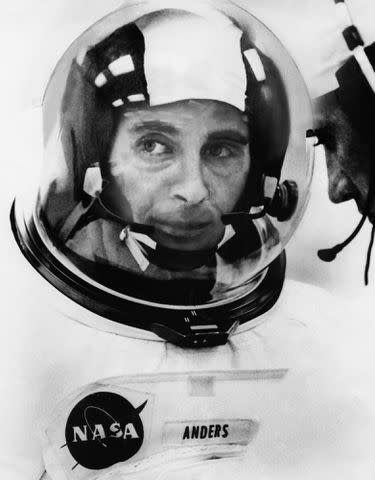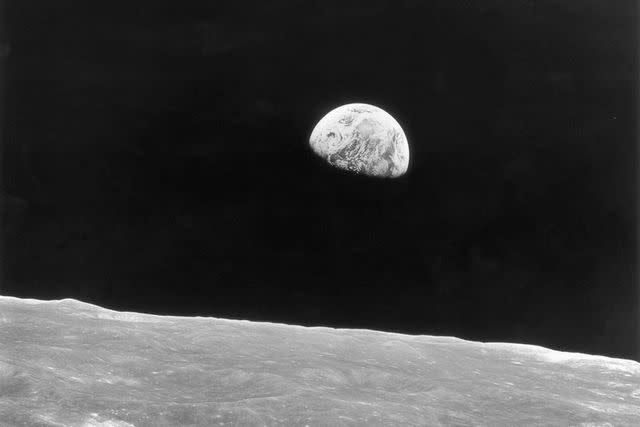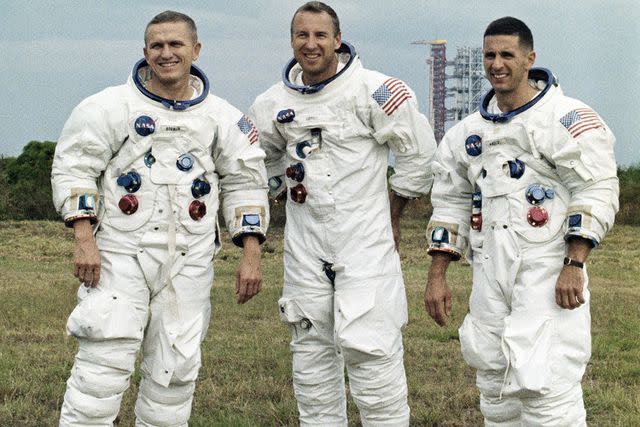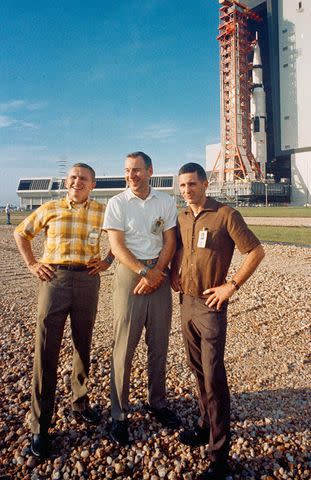Former Apollo 8 Astronaut William Anders Dead at 90 After Plane Crash in Washington
The former Apollo 8 astronaut died on Friday, June 7

J.B. Spector/Museum of Science and Industry, Chicago/Getty
William AndersRetired Maj. Gen. William Anders, the former Apollo 8 astronaut, was killed on Friday, June 7, after the plane he was piloting crashed into the ocean off the San Juan Islands in Washington state. He was 90.
His son, Greg Anders, confirmed the death to The Associated Press. The late astronaut is also known for taking the 1968 “Earthrise” image of the planet shadowed by space during Apollo 8 — the first successful mission to take astronauts to the Moon and back.
“The family is devastated,” Greg said. “He was a great pilot and we will miss him terribly.” He also confirmed the loss to The New York Times.
The FAA shared in a statement with PEOPLE that only a pilot was on board a Beechcraft T-34 Mentor plane, that "crashed into the water near Roche Harbor, Washington, around 11:40 a.m. local time Friday, June 7."

ullstein bild/ullstein bild via Getty
William Anders in 1968The U.S. Coast Guard Pacific Northwest confirmed the incident on X (formerly Twitter), posting: "#BREAKING: @USCG units along with San Juan County Sheriffs are responding to reports of a plane crash between Orcas and Jones Island. Air Station Port Angeles and Station Port Angeles are on-scene conducting search and rescue efforts. Updates to follow."
PEOPLE reached out to the U.S. Coast Guard for comment.
The late astronaut previously stated that the "Earthrise" image was his most significant contribution to the space program, as well as ensuring the Apollo 8 command module and service module worked.
Anders told Forbes in 2015 that the image “helped kick start the environmental movement,” and “the view points out the beauty of Earth, and its fragility.”
“It’s curious to me that the press and people on the ground have kind of forgotten our history-making voyage, and what’s symbolic of the flight now is the ‘Earthrise’ picture,” he added. “Here we came all the way to the moon to discover Earth.”

Keystone/Hulton Archive/Getty
"Earthrise" December 1968.Anders was born on Oct. 17, 1933, in Hong Kong, but he grew up in San Diego. By 22, he graduated with a bachelor of science degree from the United States Naval Academy, per the National Aeronautics and Space Administration (NASA) site. Seven years later in 1962, he received his master of science degree in nuclear engineering from the Air Force Institute of Technology.
Two years later, at 31 years old, he was selected by NASA to be an astronaut with responsibilities for environmental control, radiation effects and dosimetry. He was also a backup pilot for NASA’s ninth crewed spaceflight mission, Gemini XI, as well as Apollo 11, the first official moon landing in July 1969.
Notably, he was a lunar module pilot for Apollo 8 in 1968. He operated the Apollo 8 mission alongside Air Force veteran Frank F. Borman II and Navy veteran James A. Lovell, Jr. During this mission, their command module (Anders, Frank F. Borman II and James A. Lovell Jr.) floated above the lunar surface, where he snapped the iconic “Earthrise” image.
In a 1997 NASA oral history interview, he shared that he thought it was “important [for] national, patriotic and exploration reasons” to go on the mission, which, at the time, he believed was not risk-free.

AP Photo
Frank Borman ,William A. Anders and James A. Lovell on Dec. 21, 1968.Shortly after his mission, in 1969, he retired from NASA and the Air Force and served as executive secretary of the National Aeronautics and Space Council, a presidential advisory unit—a position he held until 1973.
Later that year, he became the first chairman of the Nuclear Regulatory Commission, a member of the Atomic Energy Commission, and an Ambassador to Norway. After leaving the government sector, he worked for General Electric and Textron and served as chairman and CEO of General Dynamics.
Anders retired from Air Force Reserves in 1988 as a major general, and throughout his career, he logged more than 6,000 hours of flying time.

NASA/Getty
Frank Borman, James A. Lovell Jr., and William A. Anders on October 9, 1968 in Cape Canaveral, Florida.He is survived by his wife Valerie (Hoard) Anders; his sons Alan, Glen, Greg and Eric; and his daughters, Gayle and Diana.
Never miss a story — sign up for PEOPLE's free daily newsletter to stay up-to-date on the best of what PEOPLE has to offer, from celebrity news to compelling human interest stories.
The National Transportation Safety Board and FAA are investigating the crash.
For more People news, make sure to sign up for our newsletter!
Read the original article on People.


